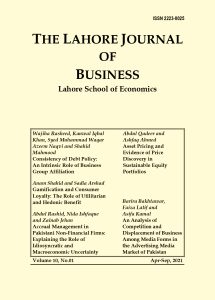Unlocking Organizational Innovativeness: Exploring the Role of Entrepreneurial Orientation and Financing in an Emerging Economy
- Memoona Kiyani
- moona_kiani@hotmail.co.uk
- COMSATS University Islamabad, Wah Campus, Wah Cantt, Pakistan
- Syeda Tayyaba Ijaz
- syedatayyaba110@gmail.com
- Lecturer International Islamic University, Islamabad, Pakistan
- (Corresponding Author)
Submitted
November 22, 2023
Accepted
November 22, 2023
Accepted
November 22, 2023
- Received
- 17 October 2023
- Revised
- 6 February 2024
- Accepted
- 28 March 2024
Abstract
Organizations and small startups play a significant role in improving the economic progress of newly industrialized countries. Their contribution to economic growth depends mainly on their innovativeness. Based on the resource-based view theory, this study seeks to understand how these enterprises use internaland external resources to uncover opportunities for innovative practices. Specifically, we examine entrepreneurial orientation (innovativeness, autonomy, risk-taking, competitive aggressiveness and proactiveness) and external financing for ventures. Through a comprehensive survey encompassing 200 ventures in Pakistan, this study reveals the significant impact of three dimensions of entrepreneurial orientation (innovativeness, risk taking, and competitive aggressiveness) and entrepreneurial finance on organizational innovativeness. This finding is important because it contributes to the growing body of literature on entrepreneurial finance and shows how financing influences innovativeness in startups, thus advancing knowledge within this field. Although the study uses a small sample, it serves as a launch pad for further studies to explore different forms of capital and their unique effects on organizational innovativeness
Keywords
Organizational innovativeness
entrepreneurial orientation
entrepreneurial
finance
resource-based view theory
This work is licensed under LJB.
- Citation
Kiyani, M., & Ijaz, S. T. (2024). Unlocking Organizational Innovativeness: Exploring the Role of Entrepreneurial Orientation and Financing in an Emerging Economy. The Lahore Journal of Business, 11(2), 29-54
- References
2: Aftab, J., Veneziani, M., Sarwar, H., & Ishaq, M. I. (2022a). Entrepreneurial orientation, entrepreneurial competencies, innovation, and performances in SMEs of Pakistan: Moderating role of social ties. Business Ethics, the Environment and Responsibility, 31(2), 419–437.
3: Aftab, J., Veneziani, M., Sarwar, H., & Ishaq, M. I. (2022b). Entrepreneurial orientation and firm performance in SMEs: The mediating role of entrepreneurial competencies and moderating role of environmental dynamism. International Journal of Emerging Markets (ahead of print).
4: Alalwan, A. A., Baabdullah, A. M., Fetais, A. H. M., Algharabat, R. S., Raman, R., & Dwivedi, Y. K. (2023). SMEs entrepreneurial finance-based digital transformation: towards innovative entrepreneurial finance and entrepreneurial performance. Venture Capital, 1–29.
5: Al-Mamary, Y. H., & Alshallaqi, M. (2022). Impact of autonomy, innovativeness, risk-taking, proactiveness, and competitive aggressiveness on students’ intention to start a new venture. Journal of Innovation and Knowledge, 7(4), 100239.
6: Azeem, M., Ahmed, M., Haider, S., & Sajjad, M. (2021). Expanding competitive advantage through organizational culture, knowledge sharing and organizational innovation. Technology in Society, 66, 101635.
7: Baah, C., Opoku Agyeman, D., Acquah, I. S. K., Agyabeng-Mensah, Y., Afum, E., Faibil, D., & Abdoulaye, F. A. M. (2021). Examining the correlations between stakeholder pressures, green production practices, firm reputation, environmental and financial performance: Evidence from manufacturing SMEs. Sustainable Production and Consumption, 27, 100–114.
8: Baker, W. E., & Sinkula, J. M. (2009). The complementary effects of market orientation and entrepreneurial orientation on profitability in small businesses. Journal of Small Business Management, 47(4), 443–464.
9: Barney, J. (1991). Firm resources and sustained competitive advantage. Journal of Management, 17(1), 99–120.
10: Block, J. H., Groh, A., Hornuf, L., Vanacker, T., & Vismara, S. (2021). The entrepreneurial finance markets of the future: A comparison of crowdfunding and initial coin offerings. Small Business Economics, 57(2), 865–882.
11: Adler, M. D., & Posner, E. A. (2000). Introduction to cost-benefit analysis. Journal of Legal Studies, 29, 837.
12: Biazzo, S., & Bernardi, G. (2003). Process management practices and quality systems standards: Risks and opportunities of the new ISO 9001 certification. Business Process Management Journal, 9(2), 149–169.
13: Bloom, N., & Van Reenen, J. (2010). Why do management practices differ across firms and countries? Journal of Economic Perspectives, 24(1), 203–224.
14: Cao, X., & Prakash, A. (2011). Growing exports by signaling product quality: Trade competition and the cross‐national diffusion of ISO 9000 quality standards. Journal of Policy Analysis and Management, 30(1), 111–135.
15: Choudhary, A., Lemos, R., & Van Reenen, J. (2018). Management in Pakistan: Performance and conflict (Working Paper F-89459-PAK-1). International Growth Centre.
16: Dick, G. P., Heras, I., & Casadesús, M. (2008). Shedding light on causation between ISO 9001 and improved business performance. International Journal of Operations and Production Management, 28(7), 687–708.
17: DiMaggio, P. J., & Powell, W. W. (1983). The iron cage revisited: Institutional isomorphism and collective rationality in organizational fields. American Sociological Review, 48(2), 147–160.
18: Dos Santos, M. G., Borini, F. M., Pereira, R. M., & Raziq, M. M. (2020). Institutional pressures and the diffusion of organizational innovation: Evidence from Brazilian firms. Technology Analysis and Strategic Management, 32(7), 869–880.
19: Fatima, M. (2014). Impact of ISO 9000 on business performance in Pakistan: Implications for quality in developing countries. Quality Management Journal, 21(1), 16–24.
20: Fikru, M. G. (2014). Firm-level determinants of international certification: evidence from Ethiopia. World Development, 64, 286–297.
Read More
